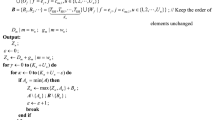Abstract
Allocation of fleet’s spare parts is rarely studied due to its complexity. However, this task is extremely important because the warship’s service level highly relies on the maintenance logistics’ level. In this study, the readiness ratio is proposed as a critical index in measuring the system’s reliability. A well-established mathematical model adopting the optimization method of spare part allocation is also introduced. The objective is to minimize the number of each spare part while satisfying the fleet’s system reliability. The fault tree analysis (FTA) is applied to analyze the system’s failure logic and stratify the units on ship. As a result, the strategy of spare part sharing can be introduced in detail. The solution algorithm is developed, and the simulation experiments to obtain the key parameters are conducted. The proposed model and algorithm are applied to an actual fleet of two warships, and results show that the method above is feasible and can be directly applied into practice.
Similar content being viewed by others
References
KENNEDYW J, PATTERSON J W, FREDENDALL L D. An overview of recent literature on spare parts inventories [J]. International Journal of Production Economics, 2002, 76(2): 201–215.
AHMAD R, KAMARUDDIN S. An overview of timebased and condition-based maintenance in industrial application [J]. Computers & Industrial Engineering, 2012, 63(1): 135–149.
MOON S, HICKS C, SIMPSON A. The development of a hierarchical forecasting method for predicting spare parts demand in the South Korean Navy—A case study [J]. International Journal of Production Economics, 2012, 140(2): 794–802.
FENG Y, YIN D, LUO B. Forecasting model for spare parts with intermittent demand based on SES [J]. Ordnance Industry Automation, 2011, 30(2): 18–21 (in Chinese).
SHERBROOKE C C. Vari-metric: Improved approximations for multi-indenture, multi-echelon avalibility models [J]. Operations Research, 2017, 34(2):311-319.
MUCKSTADT J A. A model for a multi-item, multiechelon, multi-indenture inventory system [J]. Management Science, 1973, 20(4): 472–481.
HILLESTAD R J. Dyna-METRIC: Dynamic multiechelon technique for recoverable item control [R]. US: RAND Corporation, 1982
GRAVES S C. A multi-echelon inventory model for a repairable item with one-for-one replenishment [J]. Management Science, 1985, 31(10): 1247–1256.
RUSTENBURG W D, HOUTUM G J, ZIJM W H M. Spare parts management at complex technologybased organizations: An agenda for research [J]. International Journal of Production Economics, 2001, 71(1/2/3): 177–193.
CAI Z M, JIN J S, CHEN Y Q. Warship formation spare parts allotment optimization method under multi-constraints [J]. Systems Engineering and Electronics, 2015, 37(4): 838–844 (in Chinese).
YU X. Application of OPUS 10 in formulation of ship’s initial spare parts list [J]. Equipment Manufacturing Technology, 2014, 12: 141–143 (in Chinese).
WONG H, HOUTUM G J, CATTRYSSE D, et al. Multi-item spare parts systems with lateral transshipments and waiting time constraints [J]. European Journal of Operational Research, 2006, 171(3): 1071–1093.
YI H. Research on ship’s general reliability model and reliability engineering methods [D]. Shanghai: Shanghai Jiao Tong University, 2003.
YOON K B, SOHN S Y. Finding the optimal CSP inventory level for multi-echelon system in air force using random effects regression model [J]. European Journal of Operational Research, 2007, 180(3): 1076–1085.
WANG H D, YI H, LIANG X F, et al. Analysis of the research status of ship spare parts allocation [J]. Chinese Journal of Ship Research, 2016, 11(4):133-140 (in Chinese).
LIANG X F, YI H, ZHANG Y F, et al. Numerical simulation to reliability analysis of fault-tolerant repairable system [J]. Journal of Shanghai Jiao Tong University, 2010, 15(5): 526–534.
BAO X, JI J H, LIAN H J. The ordering policy and model for critical spare part [J]. Journal of Shanghai Jiao Tong University, 2007, 41(7): 1097–1101 (in Chinese).
YI H, YUAN Y. Numerical simulation based on the minim cut sets of faulty tree [J]. Journal of Shanghai Jiao Tong University, 1997, 31(9): 117–121 (in Chinese).
LIANG X F, YI H, ZHANG Y F, et al. Reliability and safety analysis of an underwater dry maintenance cabin [J]. Ocean Engineering, 2010, 37(2/3): 268–276.
BARABADY J, KUMAR U. Reliability analysis of mining equipment: A case study of a crushing plant at Jajarm Bauxite Mine in Iran [J]. Reliability Engineering & System Safety, 2008, 93(4): 647–653.
Author information
Authors and Affiliations
Corresponding author
Rights and permissions
About this article
Cite this article
Wang, H., Li, D. & Yi, H. Optimal allocation of fleet’s spare parts for system reliability. J. Shanghai Jiaotong Univ. (Sci.) 22, 664–671 (2017). https://doi.org/10.1007/s12204-017-1888-3
Received:
Published:
Issue Date:
DOI: https://doi.org/10.1007/s12204-017-1888-3




